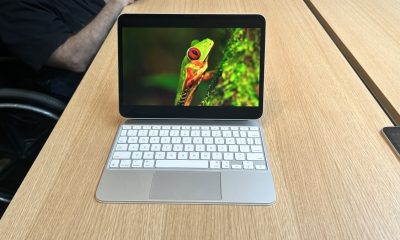Business
NASA spacecraft dives into sun’s corona

What a scene.
For the first time, a spacecraft has entered the sun’s hostile outer atmosphere, called the corona, and captured scintillating imagery of the scenery inside. NASA announced the momentous event, achieved by the space agency’s pioneering Parker Solar Probe mission, on Dec. 14.
NASA’s probe has a 4.5-inch-thick shield to protect its cameras and other instruments from temperatures that reach some 2,500 degrees Fahrenheit. The speeding craft snapped the unprecedented images below in April 2021, when it swung 6.5 million miles from the Sun’s surface. Inside the corona, we can see structures called “pseudostreamers,” which are long, radiant beams shooting out from the sun. The probe passed above, below, and around the streamers.
In the top row of images, NASA explained the pseudostreamers are seen moving upward, and in the bottom row they’re angled downward.

Pseudostreamers captured by NASA’s Parker Solar Probe.
Credit: NASA / Johns Hopkins APL / Naval Research Laboratory

An artist’s conception of the Parker Solar Probe travelling through the sun’s atmosphere
Credit: NASA
The Parker Solar Probe is doing much more than capturing wild solar scenes. The greater mission intends to dramatically improve scientists’ understanding of the sun’s intense, dynamic activity, particularly its powerful solar wind. The solar wind is a stream of energized particles constantly traveling out of the sun’s atmosphere that, during space weather storms, can “disrupt everything from our satellites in space, to ship communications on our oceans, to power grids on land,” writes NASA.
Space weather experts and solar scientists want to better grasp solar winds and even predict when hugely damaging storm events might occur.
“Parker’s measurements of the solar wind, just a few million miles from the Sun’s surface, will reveal new details that should help shed light on the processes that send it speeding out into space,” NASA explains.
For much of the Parker Solar Probe’s travels around the sun (and in the solar wind), it barrelled through a “busy barrage of particles.” But things changed dramatically once the spacecraft entered the corona, though it was only there for a few hours. Everything calmed down.
“Passing through the pseudostreamer was like flying into the eye of a storm.”
“Passing through the pseudostreamer was like flying into the eye of a storm,” NASA reported. In the corona, the sun’s dominant magnetic fields control the movement of particles emanating from the sun, so there’s more organization and less chaos.
In the coming years, the space probe’s journey around the sun will bring it swooping within 3.8 million miles of our star’s surface. Expect more intense imagery, and discovery.
“I’m excited to see what Parker finds as it repeatedly passes through the corona in the years to come,” Nicola Fox, the director of NASA’s Heliophysics Division, said in a statement. “The opportunity for new discoveries is boundless.”
-

 Business6 days ago
Business6 days agoGoogle lays off workers, Tesla cans its Supercharger team and UnitedHealthcare reveals security lapses
-

 Entertainment7 days ago
Entertainment7 days agoThe greatest films on Prime Video right now
-

 Entertainment3 days ago
Entertainment3 days agoiPad Pro 2024 now has OLED: 5 reasons this is a big deal
-

 Entertainment6 days ago
Entertainment6 days agoLoneliness in kids: Screen time may play a role
-

 Business5 days ago
Business5 days agoThe Rabbit r1 shipped half-baked, but that’s kind of the point
-

 Business7 days ago
Business7 days agoICONIQ Growth raises $5.75B seventh flagship fund
-

 Entertainment4 days ago
Entertainment4 days agoWhy should we care what celebrities like Taylor Swift and Billie Eilish say about Palestine?
-

 Business3 days ago
Business3 days agoLegion’s founder aims to close the gap between what employers and workers need





















